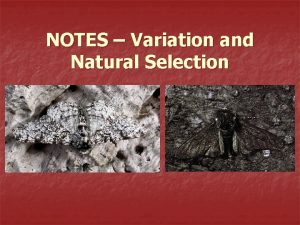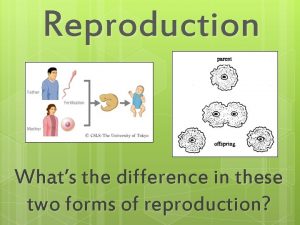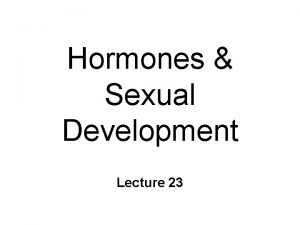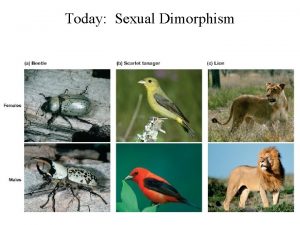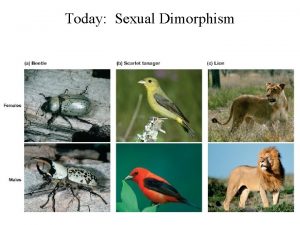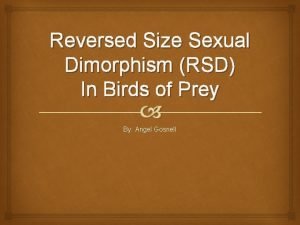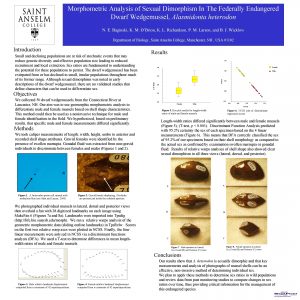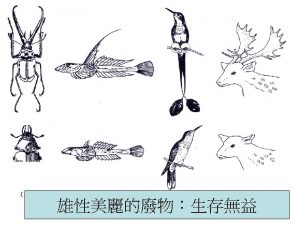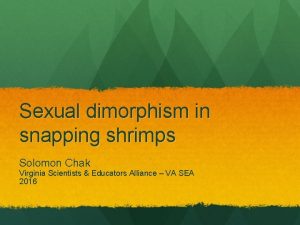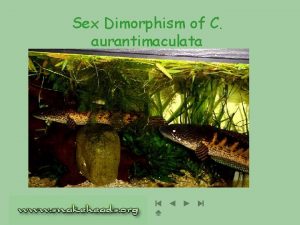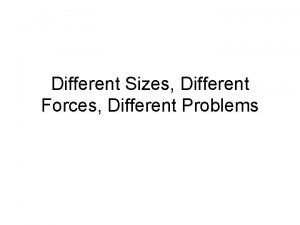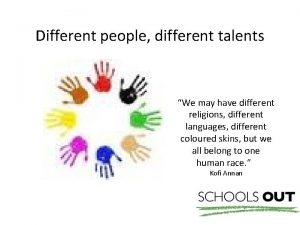Sexual dimorphism Sexual selection Is sexual selection different




























- Slides: 28

Sexual dimorphism

Sexual selection Is sexual selection different from natural selection? Darwin saw them as distinct - only sexual selection could produce traits that compromise survival The basic principle – selection favors whatever gets more genes into the next generation In sexual selection, fitness is measured relative to members of the same sex Two kinds of sexual selection Intrasexual selection – mating success determined by within-sex interactions e. g. , male-male combat Intersexual selection – mating success determined by between-sex interactions e. g. , female choice of males (also referred to as epigamic selection)

Mating systems influence sexual selection Strength of sexual selection Variance in mating success All males have same mating success = 1 mate Some males = 0 mates Some males = 1 mate Some males = 2 mates Most males = 0 mates One male = 8 mates Monogamy Moderate Polygyny Strong Polygyny

The peacock’s tail Extravagant male ornaments The peacock’s tail greatly impairs his mobility…how could such a trait evolve?

Why a theory of sexual selection? Darwin needed a theory to explain the many extravagant traits that seem to reduce survival e. g. the peacock’s tail His rationale, that conspicuous male displays persist and grow ever more conspicuous because females prefer them, never fully explained the benefit of choosing the brightest or loudest. Darwin "Thus a struggle produced by sexual selection in males exists not because of the struggle for existence, but because it give the males that possess it an advantage over other males in the competition for mates. “ Decrease in fitness (due to trait) compensated by increase in mating success

What are Females choosing? 1) Males who possess good genes 2) Males who provide resources 3) Males whose signal matches a preexisting sensory bias 4) Males who are sexy and will thus produce sexy sons who will also have success in mating

Parasitic Theory of Sexual Selection & Bright Coloration of Males "General good health and freedom from parasites are often strikingly indicated in plumage and fur, particularly when these are bright rather than dull and cryptic. " Hamilton & Zuk • females should choose parasite-free males • why? pass on resistant genes to offspring • bright colors = sign of health • If disease resistance is heritable, females are making sure they have healthy offspring if they choose such healthy looking males • prediction: relatively more brightly colored males in more parasitized species

Like a personal ad proclaiming: "Tall, good looking, disease-free, " brightly colored male animals may be advertising something of importance to their prospective mates. Should the female assume the gaudiest male has parasite-resistance genes that will benefit her offspring? Or that she simply won't pick up bugs from the guy? • decreases maneuverability & increases visibility to predators • why does it exist? why is it not eliminated? • natural selection cannot explain why traits that decrease survival exist Many sexually dimorphic male display traits seem costly. Costly displays will evolve if females actively choose males with brighter or more exaggerated traits.

GOOD GENES MODEL ELABORATED MALE TRAITS MAY BE INDICATORS OF HERITABLE GENETIC QUALITY (I. E. FITNESS). § Some males may have a heritable trait that reduces viability. § Only males with “Good Genes” can survive despite the handicap. § Females that mate with these males will have offspring with higher fitness

Hypotheses for male ornaments Fisher’s “runaway” hypothesis Mate choice originally evolved to facilitate adaptive choice for traits conferring a survival advantage Once female preference evolved, any genes that conferred survival advantage but compromised attractiveness would not be passed on because surviving males would fail to mate The female preference genes will “hitchhike” onto the successful male genes. Zahavi’s “handicap” hypotheses Extravagant male traits are costly to develop and maintain Choosing a mate with “good genes” requires an honest signal of genetic quality Only males in good condition (those with good genes) will be able to fully develop and maintain an ornament

Zahavi’s handicap hypothesis Some candidate “handicaps” Note that the handicap itself need not be heritable…it need only provide a reliable index of fitness, and fitness must be heritable Traits that encumber the owner are physiologically costly (exertion in flight) as well as being more expensive to develop Bright color honestly signals immunocompetence and parasite/disease resistance Asymmetry is indicative of developmental instability and possibly “bad genes”. Symmetry is chosen in some species

HANDICAP PRINCIPLE § The bigger the handicap, the higher the genetic quality of the male carrying the trait. § Female choice evolves and the handicap spreads and becomes elaborated. § Assumes the superior quality is heritable § This is an example of an honest signal since there is a true cost to the elaborated trait that prevents “cheaters”.

What does having a tail three times your body length have to do with good genes?

Differential Costs of a Secondary Sexual Character: An Experimental Test of the Handicap Principle Moller and de Lope 1994 • Manipulated tail lengths in males: – Shortened by 20 mm – Extended by 20 mm – Cut & Glued (treatment control) – No manipulation (control) • Survival rate: return rates to breeding sites

MATING SUCCESS RELATED TO TAIL LENGTH “Mock” altered Unaltered Barn swallow Experimental manipulation of tail length Males with elongated tails: 1. Obtain mates more quickly 2. Have greater reproductive success 3. Experience a cost in tail size the following year

Are these traits costly? In the year after Moller’s (1988) experiment on barn swallows, males with experimentally elongated tails grew significantly shorter tails than the previous year What does a long tail indicate?

Therefore: 1) trait is costly 2) tail maintained by female choice • lower loads of blood-sucking mites on males with larger tails • placed 50 mites/nest of various males • later date: offspring of males with longer tails had lower mite loads Therefore: genetic basis to resistance (good genes passed on!)

Males with longer tails fathered offspring with lower parasite loads Parasite load of offspring measured in biological parent’s nest Parasite load of offspring measured in a foster parent’s nest

Runaway Model: Trait initially advantageous Preferences and trait become genetically correlated (♂ expressed, ♀ preference) Requires heritability of trait and preference, trait cannot be too expensive. Zahavi ‘s Handicap principle Traits not chosen despite being costly, but BECAUSE they are costly they must have negative effects on fitness, so only males of the highest genetic quality can successfully develop the trait (i. e. , the trait is costly to maintain) Good genes model: ornaments are a sign of good genes, and have a cost to keep the displayer honest. Traits reveal male condition: females select males of the highest genetic quality Conditional traits- expressed by high quality males Viability: expressed by all males but tend to kill off low quality males Problem: what maintains genetic variation for goodness? Would everyone not soon have the good genes and therefore no variability for females to assess? ?

Hamilton-Zuk hypothesis: (the red queen returns) Females prefer resistant/showy males Correlation between quality (resistance) and the trait, or negative correlation between parasite load and trait Heritable variation in resistance (often difficult to prove) Parasite load reduces host viability Within a species: guppy infestations lowers male brightness, reduces sexual displays, females prefer bright males. Heritable – unknown If this is true: there should be a correlation between parasite load

Can development of these traits be condition-dependent? Many secondary sexual traits do develop in proportion to male condition: antler size (reduced by starvation in red deer) orange spots in guppies affected by carotenoid content of diet—may reflect food-finding ability tail length in swallows and widowbirds horn size in beetles—may depend on larval nutrition hormone levels that regulate secondary sexual traits—sensitive to nutrition

Some indirect benefits Carotenoid Modulation of Immune Function and Sexual Attractiveness in Zebra Finches Blount et al. One hypothesis for female choice predicts that availability of carotenoid pigments is a potentially limiting factor for both ornament expression and immune function. Males that can afford to produce more elaborate carotenoid-dependent displays must be healthier individuals with superior immunocompetence. Manipulation of dietary carotenoid supply invokes parallel changes in cell-mediated immune function and sexual attractiveness in male zebra finches (Taeniopygia guttata). Experimental Group Control Group SCIENCE, April 4, 2003

Plumage brightness in the house finch: condition-dependent Plumage color may also have a genetic component: positive correlation between plumage brightness of father and plumage brightness of sons Brightly colored plumage—reliable indicator of male parental effort; perhaps also an indicator of genetic quality? Males returning to the nesting grounds more brightly colored than the males that did not return— plumage indicates viability? Females who prefer most extreme traits will mate with males with most resistance to parasites: offspring will therefore have high resistance to parasites as well

Distinguishing between runaway sexual selection and “good genes” hypotheses Necessary condition of runaway sexual selection hypothesis: genetic correlation between male trait and female preference for that trait --but this can also be true of good genes scenario Runaway sexual selection: there is no association between the trait and fitness viability of offspring—only enhanced mating success of offspring Good genes hypotheses: require demonstration of heritable variation in male genetic quality Female choice of males with better developed traits results in enhanced fitness of offspring (which has a genetic basis)

Good Genes The "good genes" model describes the motivation for female preference. A strong, dominant mate in good health, is strong and dominant because he has a "good" genome capable of defending itself against predators, disease, and competition with other males. Male-male interactions: Males that win the most contests will be dominant, and consequently will have greater exposure to mates. A secondary sex character that allows a male to gain an advantage over competitors will mate more and consequently his genes will out compete those of other males. Over time, exaggerated traits such as antlers, spurs, or territorial song will develop in the population. Mate choice can be based on the search for "good genes" in a mate as well, but the mechanism of choice is less clear. How is it that females choose one male over another? What roles do the exaggerated secondary sex characters displayed by many males play in this choice?

The Burden of Display In the great majority of species displaying sexually selected characters, it is the male who must compete with rivals for the opportunity to mate. Why aren’t males as selective in the choice of mates as females tend to be? Male offspring number depends on # of inseminations. Female offspring number remains constant regardless of # matings. Promiscuous males will have a large number of offspring carrying his promiscuity trait, whereas a promiscuous female gains nothing when compared with a monogamous female. Extra time spent mating may be costly in terms of time and energy- =reduced fitness. Because of the fecundity constraints placed on a female, a female that selects high "quality" mates will have more fit offspring and will consequently out compete her less selective conspecifics. Males, on the other hand, have virtually nothing to lose from mating with every receptive female they encounter.

The Sexy Son The selection of the "highest quality, " or fittest mates: The fitness of a female, will be enhanced if her male offspring are more likely to survive and reproduce than other conspecifics. Why do females consistently continue to choose the "preferred" male? In the "sexy-son hypothesis" females choose the preferred male because their male offspring will later be preferred, either because they out compete other males in a dominance hierarchy or are simply more attractive to females. This benefit outweighs the cost of decreased fecundity caused by single parenting.

Parasitic Theory of Sexual Selection & Bright Coloration of Males "General good health and freedom from parasites are often strikingly indicated in plumage and fur, particularly when these are bright rather than dull and cryptic. " Hamilton & Zuk: • females should choose parasite-free males • why? pass on resistant genes to offspring • bright colors = sign of health • If disease resistance is heritable, females are making sure they have healthy offspring if they choose such healthy looking males • prediction: relatively more brightly colored males in more parasitized species Bright colours ===> GOOD?
 Dimorphism meaning
Dimorphism meaning Bb or bb
Bb or bb What is artificial selection
What is artificial selection Argumenterande tal struktur
Argumenterande tal struktur Sound will travel at different speeds in different mediums.
Sound will travel at different speeds in different mediums. Acids and bases have two different faces
Acids and bases have two different faces Sound travels fastest through
Sound travels fastest through Different materials have different
Different materials have different Why do different polymers have different properties?
Why do different polymers have different properties? What is cultural relativism
What is cultural relativism No two people
No two people Flame test principle
Flame test principle Different angle different story
Different angle different story Natural selection 3
Natural selection 3 Vestigial
Vestigial Recruitment and selection difference
Recruitment and selection difference Multiway selection in c
Multiway selection in c Artificial selection vs natural selection
Artificial selection vs natural selection Logistic model of population growth
Logistic model of population growth Mass selection and pure line selection
Mass selection and pure line selection K selected
K selected Natural selection vs artificial selection
Natural selection vs artificial selection Natural selection vs artificial selection
Natural selection vs artificial selection Two way selection and multiway selection
Two way selection and multiway selection Balancing selection vs stabilizing selection
Balancing selection vs stabilizing selection Difference between continuous and discontinuous variation
Difference between continuous and discontinuous variation Niveles hormona antimulleriana
Niveles hormona antimulleriana Whats sexual reproduction
Whats sexual reproduction Reproduction in organism
Reproduction in organism













